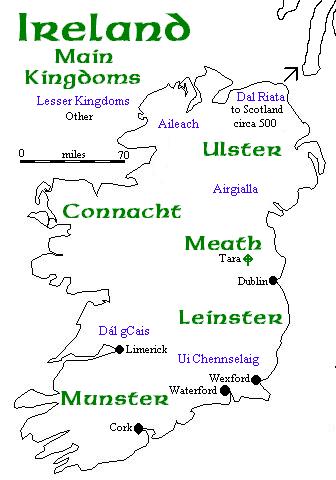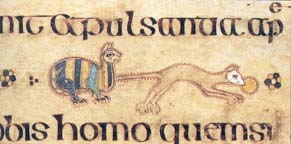Mediæval Ireland
Ancient Ireland
was divided into a large number of tiny kingdoms or túatha (TOO-uh-thuh),
about a hundred or hundred and fifty in all. Each túath had
its own king or rí (REE). These kings
could lead their own people into battle, but issued legislation only in
times of emergency such as plague or war. As well, they did not own
the land they claimed as king; instead they were farmers like everyone
else. Their wealth was counted in the area of land they farmed and
the number of cattle they owned. Each king was selected from the
males of the royal family; thus a king could be succeeded not only by a
son or grandson, but also by an uncle, nephew or cousin. Beneath
the king were nobles who were warriors and owners of cattle, freemen who
were tillers of the soil, and slaves about whom little is known and were
likely not numerous.
There were also
two higher grades of king: Overkings or ruiri (RUR-ee)
who were kings of their own túath as well as overlord of three or
more other túatha; and the rí ruiech (REE-RUR-ech)
or king of a main kingdom. Ireland consisted of five main kingdoms:
Ulster, Connacht (KON-not), Leinster (LEN-stuhr),
Munster, and Meath. The lesser kingdoms of Aileach and Airgialla
became main kingdoms later on.

|
Mediæval Ireland
Ancient Ireland
consisted of five main kingdoms:
Ulster or Uladh
Connacht or Cruachain
Meath or Midhe
Leinster or Laigen
Munster or Mumhan
There were nearly one hundred and fifty lesser kingdoms,
the boundaries of which were uncertain and
subject to constant change.
Ancient Ireland was entirely rural. Towns including Dublin,
Wexford, Waterford, Cork and Limerick were established by Viking settlers
in the 9th and 10th centuries.
|
As well, there was
the ard-rí (ARD-ree) or High King of Ireland.
From atop the Hill of Tara in the ancient Kingdom of Meath the High King
could see hills in each of the other four kingdoms. The High Kingship
of Ireland was open to kings of each of the other four kingdoms, and it
was the struggle for the honour of holding this position that eventually
led to the arrival of Anglo-Norman knights in the 12th century; thereby
ending forever the prospect of an Irish King actually ruling over all Ireland.
Ireland's Golden Age
Throughout the
early middle ages, Ireland remained comparatively isolated from Europe.
The Romans made no attempt at conquest, and Ireland was spared from the
Anglo-Saxon invasion. Ireland was untouched until the Viking raids
that began in the late 8th century.
Virtually every
king, including the most minor which were really only tribal chieftains,
had their own poet or filidh (FIL-idh) who was responsible
for preserving the history, mythology and genealogy of the group.
Literature and the arts were held in high esteem during a time when Europe
was in chaos. Although Ireland had no towns as such, monasteries
fulfilled the function of centres of learning. Rather than large
stone buildings, monasteries consisted of a little town of wooden huts,
laid out in streets and grouped around a small stone church. Scholars
from abroad were attracted to Irish monasteries where learning and culture
flourished. The Irish were most famous for their books.
 |
Between the lines of Matthew's gospel in the Book
of Kells, a striped cat watches in dismay as a rat runs off with
the communion bread.
|
Click to return to the Ireland
Page, or use your browser's back button.
Click
to Contact Robert Sewell
For lots more Irish History,
click on the image below:


